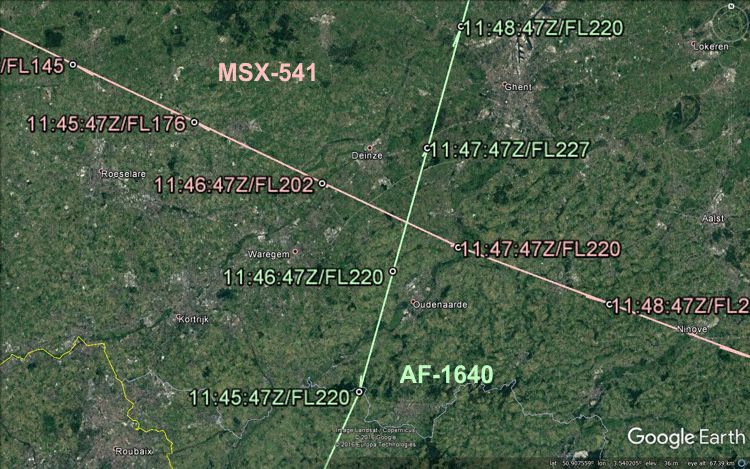The Aviation Herald reported that on 1st of January 2017 a mid-air collision was narrowly avoided between an Egyptair Cargo A300-600 (reg. SU-GAY) and an Air France A320-200 (reg. F-GKXN), above the vicinity of Ghent. In an interim report the Belgian Federal Public Service Mobility and Transport (Air Accident Investigation Unit) wrote that the Egyptair pilots misinterpreted the TCAS RA instructions.
The Egyptair plane performing flight MSX541 with destination Cairo had left Ostend-Bruges Airport with clearance to climb to FL210 . The Air France aircraft was performing flight AF1640 from Paris CDG to Amsterdam at FL220 on a converging trajectory.
MSX541 was instructed to climb to FL210 about 5 minutes before the trajectories were about to cross and was read back correctly again. Two minutes prior to the crossing point, ATC instructed MSX541 to maintain FL210 and provided traffic information of the crossing AF1640 above.
MSX541 however continued the climb above FL210. Both aircraft received TCAS resolution advisories. AF1640 was instructed to climb and complied. MSX541 however continued their climb opposed to the TCAS resolution advisory.
Belgium’s Air Accident Investigation Unit (AAIU) reported that the separation between the two aircraft was reduced to 300 feet vertical and 0.74nm horizontal.
MSX541 continued to climb and went on to Cairo for a safe landing. AF1640 returned to FL220 after the incident and continued to Amsterdam for a safe landing.
Belgium’s AAIU rated the occurrence a serious incident: MSX541 was instructed three times to climb/maintain FL210 and was provided with traffic information in the last of these instructions. However, the aircraft continued to climb above FL210 resulting in TCAS resolution advisories on both aircraft. MSX541 received a “LVL” resolution advisory, AF-1640 received a “CLB” resolution advisory.
The graph (times and altitudes) hereunder shows the seriousness of the incident (copyright AVH/Google Earth/AvHerald).

Update: Safety issue identified: Misinterpretation of TCAS RA instructions
Misinterpretations of TCAS RA instructions were already identified in the past. In particular, the instruction to stop climbing was, in the past, announced by the message “ADJUST VERTICAL SPEED”. In several cases, this announcement was wrongly understood by crews and led to Airprox events. The TCAS system was therefore modified in order to change the “ADJUST VERTICAL SPEED” announcement to a clearer “LEVEL OFF” announcement.
In this case, both aircraft were equipped with the updated version of TCAS (TCAS II version 7.1.) and all crew members involved (AFR and MSX) received training on the updated equipment. However, TCAS RA events are not happening frequently and individual crew members are rarely faced with such event, for which the procedure requires a quick and adequate response. Solutions were brought to this potential problem by some airlines (including most Belgian companies) to include a TCAS event during flight simulator exercises.
Analysis (What if)
Eurocontrol has analysed this event and developed “What-if” scenarios with the inCAS simulation software.
- Scenario A: MSX541 responds timely to the initial Level Off RA (nominal 5-sec. delay): MSX541 would have levelled off at FL207. No RA would have been issued for AFR640F.
- Scenario B: MSX541 responds to the initial Level Off RA with a delay of 10-sec.: MSX541 would have levelled off at FL209. No RA would have been issued for AFR640F.
- Scenario C: AFR640 responds timely to the Climb RA (nominal 5-sec. delay) and MSX541 climbs as recorded in the real event: Vertical spacing at CPA would have increased to 497 feet (i.e. by 71 feet).
- Scenario D: AFR640 not responding to the Climb RA or unequipped and MSX541 climbs as recorded in the real event: Vertical spacing at CPA would have reduced to 215 feet (i.e. by 211 feet).
A word of explanation: the traffic collision avoidance system (abbreviated as TCAS, and pronounced tee-kas) is an aircraft collision avoidance system designed to reduce the incidence of mid-air collisions between aircraft. It monitors the airspace around an aircraft for other aircraft equipped with a corresponding active transponder, independent of air traffic control (ATC), and warns pilots of the presence of other transponder-equipped aircraft which may present a threat of mid-air collision (MAC).
The next step beyond identifying potential collisions is automatically negotiating a mutual avoidance manoeuvre (currently, manoeuvres are restricted to changes in altitude and modification of climb/sink rates) between the two (or more) conflicting aircraft. These avoidance manoeuvres are communicated to the flight crew by a cockpit display and by synthesised voice instructions.
The airborne collision avoidance system is mandated by the International Civil Aviation Organization (ICAO) to be fitted to all aircraft with a maximum take-off mass (MTOM) of over 5,700 kg or authorised to carry more than 19 passengers.




Discuss: http://www.luchtzak.be/forums/viewtopic.php?f=7&t=60710
We did mention the two distances, horizontal and vertical, and said that the aircraft never were closer than 1370m.
But the minimum horizontal separation should be 10,000m.